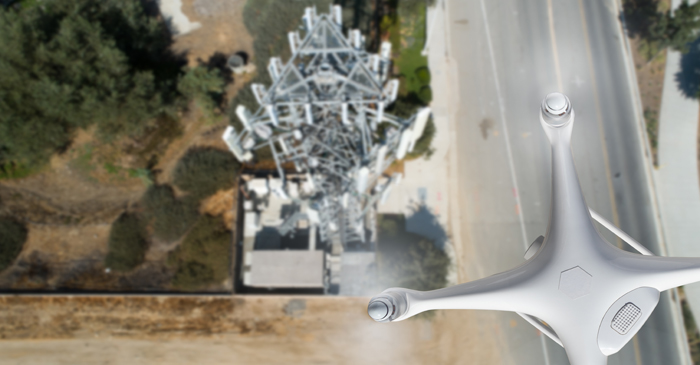26th February 2021 | Matthew Clark, Business Development Manager
The growth of commercial drone usage

Matthew Clark
Business Development Manager
Since the rise of drone usage outside of military settings, industrial and commercial use cases typically include delivery of goods, infrastructure maintenance, surveying and mapping, and asset inventory management.
One of the main catalysts for this increase in commercial drone usage has been the advancements in communication networks that allow for Beyond Visual Line Of Sight (BVLOS) flight. This is largely due to the commercial viability of 4G and the possibilities that 5G will bring.
Cellular provides a resilient and secure solution for drone connectivity as it is standardised, scalable and quick to deploy. So, how has cellular benefitted the commercial drone market thus far with 4G, and what changes will the rollout of 5G bring in coming years?
Building a foundation for the commercial drones industry through 4G
At a time where organisations feel the pressure to be more innovative and ambitious, drones offer a unique opportunity. The global market for commercial drones is growing at a rapid pace, having reached $6.5 billion in 2020 and expected to grow to $34.5 billion by 2026.
Drones are dependent on a range of technologies, including wireless connectivity, sensory systems, power storage and in some cases Artificial Intelligence (AI). As many drones use a BVLOS system, wireless communication is critical to allow for communication over a great distance, discarding the use of lower power transmitters. Military drones typically use dedicated radio communications through satellites or large mobile antenna systems, however these are less accessible to commercial organisations because they are expensive to use. Therefore, cellular connectivity has provided the foundation for affordable commercial drone communication.

With the small number of commercial drones that are currently being used – as well as regulatory frameworks that are still in the early stages of being developed – 4G provides a strong foundation for the growing market. This includes delivering the connectivity speeds, resilience and latency that can sufficiently support network requirements for video feeds, location and route management. However, there will soon be a need for more sophisticated network capabilities to manage demand and more stringent regulatory requirements. Although it is not widely available today, 5G will become a key enabler for this growth in commercial drone usage.
Expansion of 5G
5G will help the commercial drones market to scale in a compliant and safe manner, by delivering the higher bandwidth, ultra-low latency capabilities (helping with issues such as collision avoidance), and higher levels of security and safety that regulators will demand as drone usage increases. With the majority of commercial drone use cases currently operating outside of built up areas, we cannot expect to see the full benefits that 5G is forecast to bring until rural coverage improves significantly.
The commercial drones industry has the potential to benefit from the expansion of 5G, but organisations will need to consider current and upcoming government legislation if they are to streamline their services. 5G and drone technology have created a symbiotic relationship by constantly developing, and likewise businesses should be evolving to keep up with new and sophisticated technologies as 5G coverage improves.
The importance of regulation and legislation
As commercial drone usage increases over the coming years, we will likely see several thousand drones roaming the skies. This will present a range of issues including safety, privacy and security. As such, stricter regulations will be enforced to minimise the risks of large, heavy objects flying overhead in a shared airspace.
Physical safety concerns include drone on drone, structure, aircraft or even human collisions. There are also potential security issues to consider, such as drones being hacked or stolen. Additionally, as commercial drones are fitted with high-res cameras, people will want to understand how collected data is being managed in accordance with data protection legislation. This concern has become more prevalent with recent negative headlines, such as the Frankfurt airport disruptions in 2020, or in 2018 at Gatwick airport.

Regulation is already being developed across the world. Canada has mandated that all pilots must have a drone pilot certificate, with no allowance of BVLOS and designated ‘No Drone Zones’. In the UK, new legislation is being debated that will mandate that all active UAVs will need to transmit their location services for safety purposes. Commercial drone users will also have to be granted permission from OFCOM and the UK’s Civil Aviation Authority to show they have met the government’s conditions for operating.
Technology will play an important role in managing these challenges. Capabilities such as SIM density mapping will aid the management and control of UAVs. Elsewhere, geo-fencing will automatically prevent drones from flying into protected areas, and electronic conspicuity can provide automatic identification of all airspace users.
Mobile operators are already adapting to future restrictions. Technological breakthroughs such as the creation of flight paths for industrial drones will enable drones to avoid geofenced areas. Vodafone and Ericsson successfully tested ‘safe sky corridors’ for drones; as a result, drones were able to collect anonymised mobile user information to avoid crowded areas on the ground through the use of Application Programming Interfaces (APIs). This combats key concerns over BVLOS systems.

Partnering for Success
It’s clear that connectivity will play an increasingly important role in the growth of the commercial drone market in the coming years, with complex issues from resilience and security, to license applications and safety to consider.
It’s critical that organisations choose a specialist connectivity partner like Wireless Logic, who has the expertise to navigate these challenges and ultimately can deliver a resilient, compliant and future proof solution.
More information about how Wireless Logic can support you can be found here.
Alternatively, call us on 0330 056 3300.


